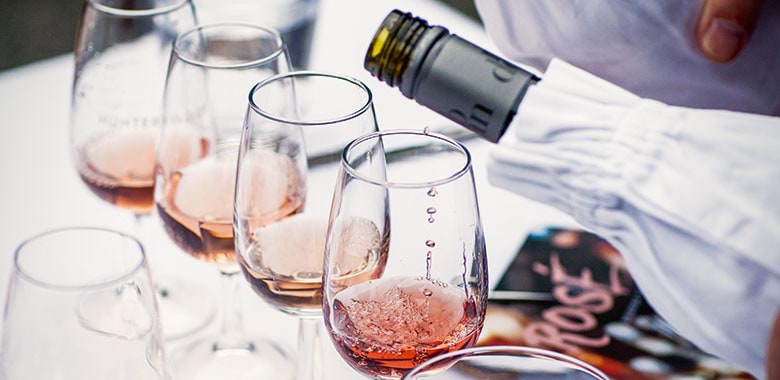
Wine
Australian Rosé Awakening Member Tasting
Don’t call it a comeback. Rosé has been around for years, if you’ve known where to look. Unfortunately, many people think of Rosé as the sickly sweet style their auntie, or grandma likes to drink poolside at family gatherings. And, despite it being 2017, some men are still frightened of Rosé’s pink colour...perhaps someone in marketing could put a ‘B’ in front of it? But why pander? Let them miss out. There’ll be more for you and me!
Rosé is one of the wine world’s greatest gifts. Versatile, it goes with just about any meal, at any time of day or night. Refreshing, a well-made Rosé has the ability to slake a thirst like no other wine. And, delicious – these days, Aussie winemakers are crafting Rosés that are a pure pleasure to drink.

It's All in the Grape
Rosé can be made from just about any red wine grape variety there is. In Australia, the more common varietals used to make Rosé include Shiraz, Pinot Noir, and Grenache. But also, Merlot and Cabernet Sauvignon. In Provence, the historical home of Rosé, winemakers will blend grape varieties, such as Cinsault, Mourvédre, Syrah (Shiraz), and Carignan, to create gorgeous examples of this pale pink wine.
Just like red wine, Rosés pick up their colour from the skin of red wine grapes. The winemaker can determine the depth of colour in the wine by deciding how long to leave the juice in contact with the skins – the shorter the time, the lighter the colour. This can be done using a number of different techniques. The maceration method allows the crushed skins of the red wine grapes to ‘steep’, or macerate, in the juice for a short period of time, before the skins are removed and the entire tank is finished into a Rosé wine.
Another method is called the Saignée (‘san-yay’), or the ‘bleed’ method. This involves ‘bleeding off’ a portion of the juice – while the remaining goes on to make red wine – into a separate vat to finish fermentation. This technique can result in some really lovely examples. Another way to make Rosé is by mixing white and red wine together, although, this rather crude method is generally frowned upon and doesn’t usually make for a very nice tasting wine.
The colour of Rosé can range from the lightest shades of pale onion skin pink to salmon, coral, hot pink, and ruby red; generally speaking, the darker the colour, the more intense the wine. Primary fragrances and flavours of Rosé depend on the type of grape, or grapes, used, but will typically sit along the spectrum of red fruits and florals, melons and zesty citrus. Sometimes, you’ll find pleasant green characters, like rhubarb or strawberries with their leafy green tops still on.
Summer Lovin' Rosé
American novelist, Jay McInerney once remarked of Rosé, “Anyone who starts analysing the taste of a Rosé in public should be thrown into the pool immediately.” Perhaps, because it is pink in colour and frivolous by nature – a wine destined to be drunk sooner than later – Rosé invites such mockery from wine ‘experts’ and pundits. Which is not to say that all Rosés won’t age. Some do, for a few years at least, but, like a hot summer romance, most just aren’t made to last. Indeed, Rosé is made to be drunk on warm days; outdoors, in the shade, with a lover, or with friends, some food and a gentle breeze. Fortunately for us, here at Selector we had all of these things (minus the pool) on hand when seven lucky Wine Selectors Members joined Wine Selectors Tasting Panellists Nicole Gow and Adam Walls, plus Hunter Valley winemaker Andrew Duff from Tempus Two Wines, for lunch at Carrington Place in Newcastle, to taste and discover the colourful and refreshing state of play of Australian Rosé.
“Up until a few years ago, Australian winemakers made Rosé as an after thought,” Adam told the Members at the tasting lunch. “Whereas now, the wines are being made deliberately, with designated parcels of fruit that have been picked specifically to be turned into Rosé.”
The Members, along with the Panellists, blind tasted through 16 Rosé wines, over four brackets, and recorded their tasting notes accordingly. The wines were selected from right across Australia, with examples from the Yarra Valley, Adelaide Hills, and Hunter Valley performing well. Winemaker Andrew Duff, whose 2016 Tempus Two Copper Series Rosé won the trophy for best Rosé at the most recent Hunter Valley Wine Show, was impressed by the diversity of Rosé wines in Australia now, and said that balance was the key.
“It was great to see the different regions, side by side, all contributing to the different styles of Rosé,” said Andrew. “There was a lot of balance in the examples we tasted. None were too sweet, many were dry, but still expressed lovely fruit forwardness with delicacy.”
Australian Rosé - Fresh Converts
After a bashful start, the Members soon took to the tasting like yeast cells to sugar, and started fermenting their own thoughts about Rosé.
“I haven’t always liked Rosé, because I’ve found it to be light and lacking flavour” said Luana Genua. “After today, however, having learnt a bit and tasted so many examples that were all so different, I think it’s safe to say I’ve been converted.”
The tasting was a chance for the Members to experience Rosé in a relaxed setting, with great food, and to speak to industry professionals, which led to more than a few new discoveries.
“I love Rosés, especially when they’re crisp and dry, and not too sweet,” said Amy Bruniges. “I discovered today that Rosés are really good with all different types of food, and I loved how easy they were to drink.”
“I consider myself to be a red wine drinker, and I thought Rosés were always just sweet wines,” explained Todd Settle. “But I’ve been surprised by how many examples we tasted today that I found very drinkable and enjoyable.”
Tasting Highlights
A couple of firm favourites emerged across the whole Panel, which included Bird in Hand’s 2016 Pinot Rosé from the Adelaide Hills, the Yarra Valley’s Seville Estate The Barber Rosé 2016, and the trophy winning Tempus Two 2016 Copper Series Rosé from the Hunter.
With so much pleasure to be found in a glass of Rosé, it would be hard for anyone to attempt a serious analysis of such a fun-loving wine. To do so would surely strip it of its joyful and blushing vibrancy, and we’d all deserve to be thrown in the pool! Yet, to not conduct a tasting like this, with such an impressive line-up, paired to good food and great company, would be just as foolish, because, as everyone realised, you never know what you’re likely to discover!